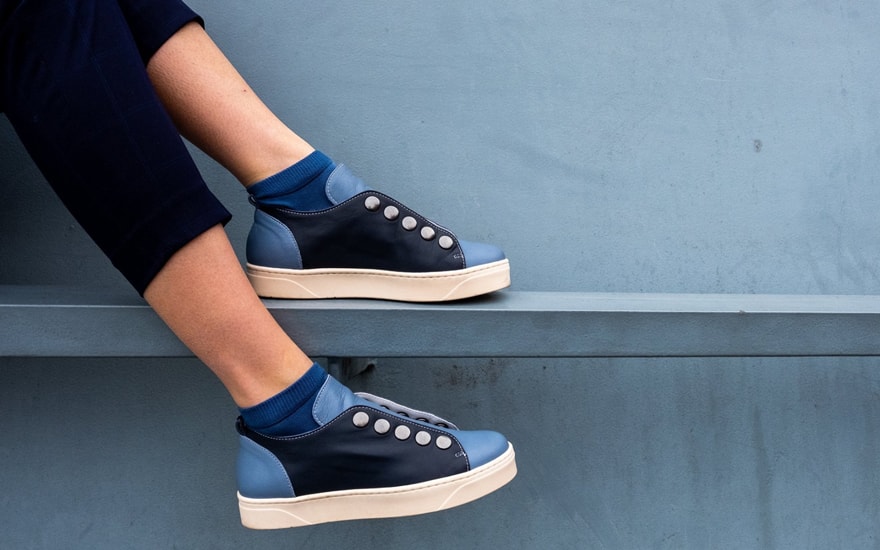The story of online shoe brand Sjosuur
Veröffentlicht am 15/09/2020 in Start Like A Pro
“Our business model is more suited to online business than physical shops.”

How it started
By her own account, Laurence Verhaert is not your typical shoe addict. “But I’ve always had a keen interest in design.” Laurence explains: “That’s why I enrolled in a training programme on shoe design at the SASK (municipal academy of fine arts) in Sint-Niklaas.” That’s where the seed was planted for Sjosuur, an online shoe store where Laurence stresses, creativity and recognition for local artisanship are central.
“When we buy shoes we rarely stop to consider who designed and made the shoes; their origins are often lost”, she says. “Sjosuur aims to bring the wearer, the designer and the craftsmen closer together. That is why I team up with emerging and less-known designers.” Her target group are people who love shoes but for whom sustainability is an absolute priority and who are interested in the local and artisan aspect.
Why an online shop?
Sjosuur takes a different approach than the offer in physical shops, which is geared to mass-produced footwear from such countries as China. “We design and manufacture locally as much as possible. As a result, the product is of superior quality but inevitably also slightly more expensive. In addition, we break the seasonal mould so shopkeepers don’t have to factor in seasonal discounts. In any case we work with small volumes. The number of pairs per model is always limited.”
It didn’t take long for Verhaert to realise that her ‘slow fashion’ approach was ideally suited for online business. “Opening an online store or marketing your collection there often requires more financing and you also have to take the seasons into account. Moreover, stores prefer to do business with established brands. An online shop offers more possibilities to build name awareness.”
Instagram to stay in touch with the target group
Thanks to her background as a marketing consultant Verhaert is certainly no stranger to (online) marketing. Still, Verhaert emphasises that “the main thing is to start from our story and our brand”. Her website and webshop are the crux of the story because they are the staging point for her own designs and those of the other designers.
In terms of social media she opts for Instagram, Facebook, Pinterest and YouTube. “Instagram gives you the possibility of discovering how the target groups react to your brand. The visual aspect obviously also comes in handy when you’re selling shoes”, she adds.
Importance of social media
Facebook has the advantage of a wide reach.” Many people are active on Facebook. The trick is to tap into your own target group there.” As for YouTube, it’s a good medium to show videos presenting the (latest) shoe designs but also to tell the story of local artisanship. “Social media definitely helps to spread your story among your target group but more than anything they support your brand and online sales.”
To position the brand in the market she opts for a combination of both earned media (e.g. her Instagram followers) and paid media (paid advertisements). This means she also purchases targeted advertisements, such as on Google.
What else is involved?
An online shop is also about practical things such as logistics and payment. “I delegate a lot of those aspects to staff, especially the practical side of things. I want to focus primarily on design and strategy. I use an external warehouse although I do have a number of pairs of shoes at home.” Logistics and payment are handled through classic channels. “These things are easy to outsource nowadays.” For instance, Mollie is her payment provider. Her delivery partners are Bpost, Postnl, dpd, DHL and GLS.
As Verhaert was no stranger to e-commerce and online marketing and had already carried out similar projects for clients, she got off to a reasonably smooth start. Starting entrepreneurs who are less well-versed in these things can, for instance, use packages marketed by providers such as Proximus. Proximus has an offer for starters including, among others, professional assistance with the creation of their website and webshop.
What does the future have in store?
What does the future have in store for Sjosuur? “We are going to try as many different things as possible to see what works and what doesn’t. I want to let things grow organically, parallel to my activities as a marketing consultant”, she says. Working with limited stocks also keeps the whole enterprise manageable from a financial standpoint. “But if you’re spending money you also need sales to cover those expenses.
With a webshop you should count on three years to break even but it’s fun and it keeps me on my toes.” She’s definitely ambitious. The aim is to grow Sjosuur into a European player, with European customers. “Achieving genuine growth means targeting the European market, which dovetails with my approach of using designers from Spain and Italy”, she explains. “The Belgian market is really too small for a project like Sjosuur. You have to go European.”
For even more expert advice, interesting links or suggestions for tools to guide you as a Starter step by step, please visit Start Like A Pro.
Start Like A ProStart Like A Pro
Einschlägige Tipps und Links unterstützen und leiten Sie an, damit Sie unter optimalen Bedingungen loslegen können